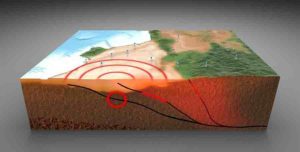
Devastating historical earthquakes and tsunamis in Indonesia can be traced to a recently discovered submarine extensional fault system, where sediment slumping along the fault zone triggers the tsunamis, according to a study published in Nature Geoscience. These findings provide a new theory for earthquake and tsunami hazard in this highly tectonically active region.
A number of destructive events in the Banda Sea have been documented from the seventeenth century onwards, including detailed reports of the large 1852 Banda earthquake and tsunami in Indonesia. This event, along with the others, had been assumed to have been caused by compressional faults in the subduction zone—where one tectonic plate plunges below another—that underlies the Banda Sea. However, there is geological evidence of submarine extensional faulting that suggests this region has recently been experiencing stretching rather than compression.
Phil Cummins and colleagues combined existing geological information with GPS observations of crustal motion and an analysis of historical earthquakes and tsunamis in the region, with a particular focus on the 1852 event. They found that the 1852 Banda earthquake and four other historical earthquakes that devastated the Banda Islands were triggered by the shallowly dipping extensional fault system, rather than a deeper source related to subduction. Furthermore, the authors found that slumping of marine sediment destabilized by the earthquakes along the fault zone triggered the tsunamis, rather than the tsunamis being directly triggered by the earthquakes themselves.
The authors conclude that their findings demonstrate that earthquake-induced sediment slumping can trigger large tsunamis, and that—in the Banda Sea—seismic activity in a region of extensional tectonics is a source of large earthquake and tsunami hazard for Indonesia.
Reference:
Phil R. Cummins et al. Earthquakes and tsunamis caused by low-angle normal faulting in the Banda Sea, Indonesia, Nature Geoscience (2020). DOI: 10.1038/s41561-020-0545-x
Note: The above post is reprinted from materials provided by Springer Nature .










